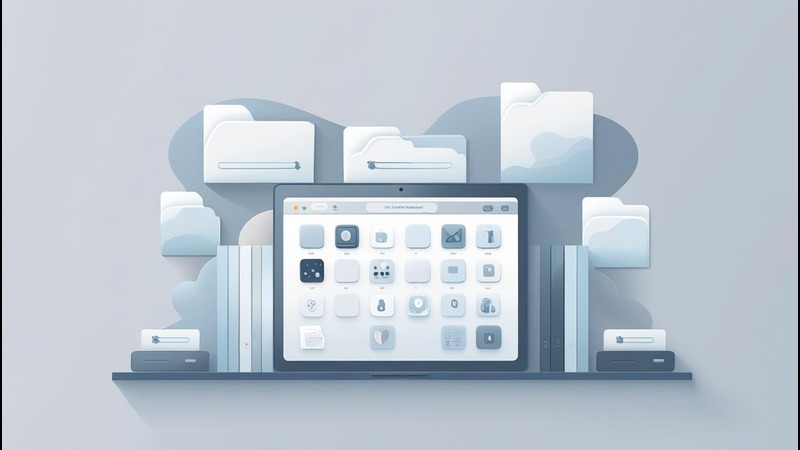
Digital Minimalism: How to Declutter Your Online Life
In the modern age, we are constantly bombarded with digital stimuli. From social media notifications to endless email chains, our digital lives can often feel overwhelming. Digital minimalism offers a path to reclaim control and bring intentionality to our technology use, leading to greater focus, clarity, and peace of mind. This guide provides a structured approach to decluttering your digital life and cultivating a more balanced relationship with technology.Section 1: In-Depth Assessment of Digital Clutter
The first step towards digital minimalism is to understand the extent of your current digital footprint and identify sources of clutter.
- Conduct a Thorough Analysis of Application Utilization: Scrutinize the apps installed on your devices. Review usage statistics to pinpoint which applications consume the most time. Consider whether each app truly serves a valuable purpose or merely distracts from essential tasks. Categorize applications as essential, valuable but time-limited, or extraneous.
- Identify and Document Activities That Result in Unproductive Time Consumption: Track how time is spent online. Note activities that offer little to no personal or professional benefit, such as excessive scrolling through social media feeds, engaging in endless debates, or watching irrelevant videos. Document these activities to gain awareness of time-wasting patterns.
- Compile a Comprehensive List of Superfluous Subscriptions: Review subscriptions to email newsletters, online services, and digital platforms. Identify those that no longer provide value or have become redundant. Consider the frequency of use and whether the content genuinely enriches life. Unsubscribe from those deemed unnecessary.
- Evaluate the Influence and Consequences of Social Media Engagement: Reflect on the impact of social media on mental health and overall well-being. Assess whether engagement primarily involves genuine connection or unproductive comparison and validation-seeking. Analyze if social media use detracts from real-life relationships and activities.
Section 2: Detailed Implementation of Decluttering Protocols
Once the digital clutter has been identified, the next step is to implement concrete decluttering strategies.
- Initiate the Cancellation of Non-Essential Electronic Newsletters: Methodically unsubscribe from newsletters that overload your inbox or no longer align with interests. Prioritize newsletters that provide substantial value or information. Use email filtering tools to automatically direct less important newsletters to a separate folder for later review.
- Remove and Uninstall Redundant or Unused Software Applications: Audit the applications on computers, tablets, and smartphones. Delete applications that are rarely used or have been replaced by alternatives. Streamline the digital environment by only retaining essential and frequently utilized applications.
- Establish an Organized and Efficient Digital Filing System: Create a logical folder structure for digital files. Implement a consistent naming convention to facilitate easy retrieval. Regularly backup essential data to prevent loss. Consider cloud storage solutions to access files from multiple devices.
- Establish and Enforce Time Constraints for Social Media Platforms: Set daily time limits for social media use. Utilize built-in app timers or third-party applications to monitor and control time spent on social platforms. Allocate specific time slots for social media interaction and avoid engaging outside of those designated periods.
Section 3: Strategies for Sustaining a Minimalist Digital Environment
Maintaining digital minimalism requires ongoing effort and conscious attention.
- Perform Regular Evaluations of Individual Digital Behaviors and Patterns: Conduct periodic self-assessments to review digital habits. Reflect on how technology is being used and whether it aligns with intentions and values. Identify emerging sources of digital clutter and address them promptly.
- Adopt a Deliberate and Conscious Approach to Technological Engagement: Cultivate mindfulness when using technology. Avoid mindless scrolling or passive consumption of digital content. Engage with technology intentionally, with a clear purpose or goal in mind. Be present and aware during digital interactions.
- Designate Specific Areas or Periods Devoid of Technological Devices: Create tech-free zones in the home, such as the bedroom or dining area. Establish tech-free periods during the day, such as mealtimes or before bed. Disconnect from devices to engage in other activities and foster real-life interactions.
- Place Emphasis and Priority on In-Person and Real-World Interpersonal Interactions: Prioritize spending time with loved ones. Engage in face-to-face conversations. Cultivate meaningful relationships and connections in the physical world. Limit the use of technology during social gatherings.

